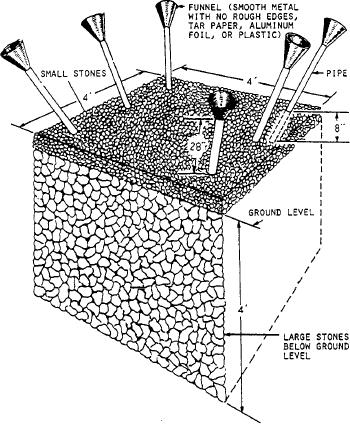
The pipes should reach at least 8 inches below the
ground surface. In the upper end of each pipe, place a
funnel of sheet metal, tar paper, or similar material.
These funnels are covered at the opening with wire
mesh. This is to keep out flies, cigarette butts, or other
items that would clog up the pipes.
In other cases, pail latrines maybe used in buildings
where no adequate plumbing facilities are available or
where it is not practical to build deep pit latrines. Usually
a standard latrine box is adapted for use as a pail latrine.
The pails are removed at least once daily and replaced
by clean pails. Each pail should have about 1 inch of a
2-percent cresol solution or some slaked lime in it.
Pails of excreta are removed from the latines by
hand, cart, wagon, or truck. The contents maybe burned,
buried, or placed in flyproof concrete tanks where it
decomposes.
A trough urinal is usually built as part of a latrine.
The trough may be made of tin, galvanized iron, or
wind. When it is made of wood, it should usually be
lined with tar paper.
Figure 10-56.--Urinal pipes and soakage pit.
The trough slopes toward one end and empties into
a drain pipe. The drain pipe, fitted with a fine mesh fly
four or eight holes, and accessories, such as tent, urinals,
screen, extends into the latrine or urine soakage pit.
tar paper, and screen wire, are finished ready for
Sometimes the pipe is omitted and the trough extends
installation.
into the pit.
When the box is installed, it is lined with tar paper
from the top to the bottom. The boxes also need a metal
or tar paper urine deflector. This deflector is converted
GARBAGE DISPOSAL
into a trough under the front of the seat so it drains
toward one end. From this end, a pipe carries the urine
Garbage is the waste from the kitchen and mess hall.
to an outside soakage pit. This helps prevent a
It is usually divided into two categories: WETand DRY.
disagreeable odor from the urine. In some cases where
Both have to be removed from the mess area before they
the soil is rather porous, the urine drains into the latrine
cause offensive odors or attract flies and rats.
pit itself.
Cans should be used for storing garbage until the
It is necessary to cover all cracks in the box to help
garbage can be removed for disposal. The cans should
make it flyproof. You do this by nailing strips of wood
be kept outside of the kitchen. Covers must be kept on
or tin over them. When the box is placed over the pit, it
the cans at all times. Cans should not be filled higher
must be done carefully. If any cracks are showing, seal
than 4 inches from the top. Regular washing of the cans
them by packing some dirt tightly around the edges.
is necessary to help ensure proper sanitation. When
A separate urine soakage pit is built when the latrine
steam is available, it can be used to remove accumulated
pit is in soil that absorbs liquids poorly (fig. 10-56). This
grease.
pit is about 4 feet square and 4 feet deep. It is filled with
The common method of disposal is burial. Trenches
pieces of broken rock brick large stone or lava rock to
or pits are dug and the garbage is deposited. Sometimes
within 1 foot from the top. Then oiled burlap is placed
a continuous trench is used. The garbage for each day is
over the rocks and covered with sand or earth. Vents,
then covered by the excavation made for the following
inserted to reduce odor, are covered at the top with fine
day. The length, width, and depth of the holes vary
mesh screen.
according to the need; however, you should not pile the
Urinals may be made of 1-inch or large-sized pipe
garbage higher than 2 feet from the top before covering
and placed at each corner of the pit and along the sides.
it with earth.
10-41

